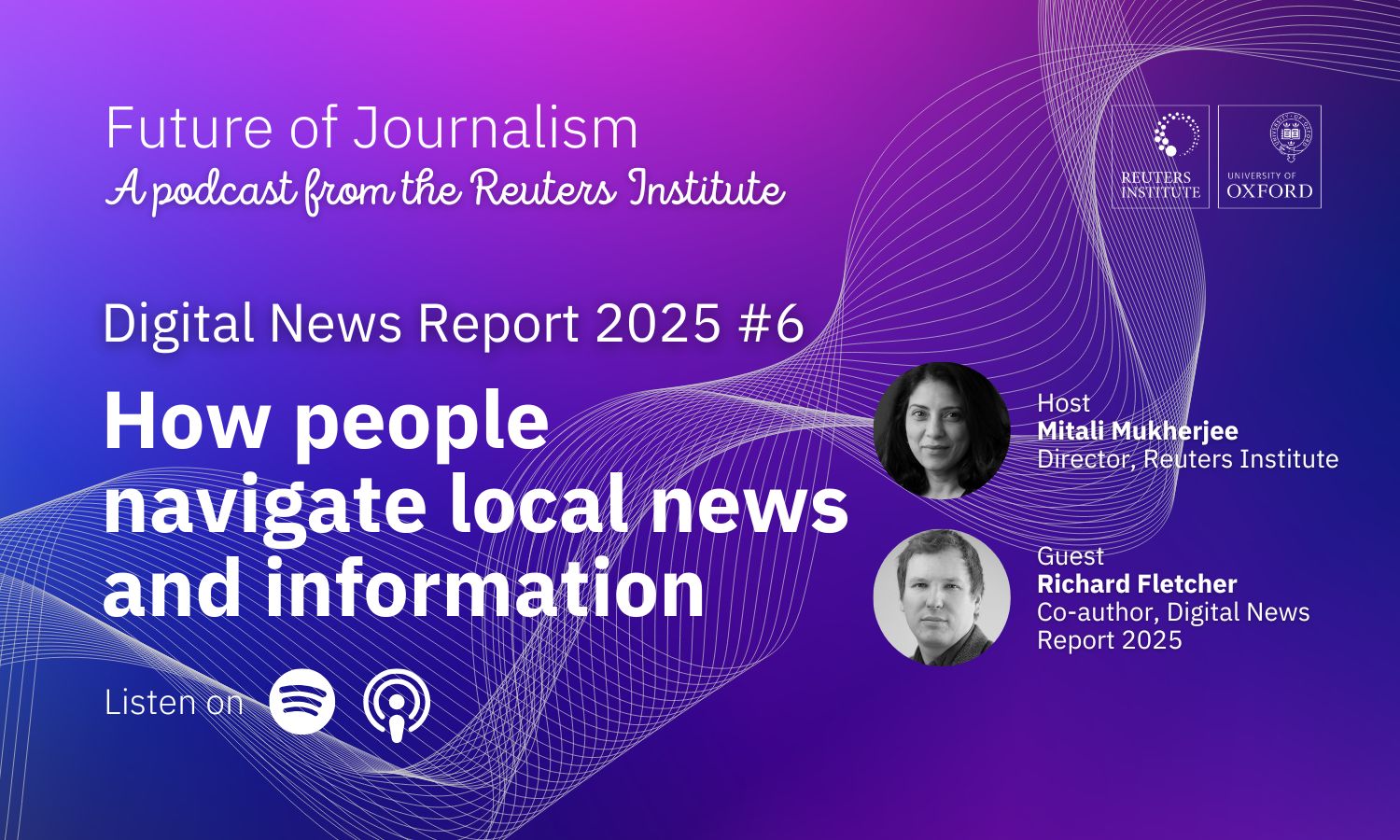Our podcast: Digital News Report 2025. Episode 6: How people navigate local news and information

In this episode of Future of Journalism we look at the levels at which people access news and information about topics in their local area and whether they prefer to use local news outlets or platforms to do so. We explore how this correlates with interest in news in general and how these trends vary around the world. We also discuss how news publishers can better engage audiences on a local level.
Speakers
Richard Fletcher is a co-author of the Digital News Report and is the Director of Research at the Reuters Institute.
Host Mitali Mukherjee is the Director of the Reuters Institute and is a political economy journalist with more than two decades of experience in TV, print and digital journalism.
The transcript
Pressures on local news | Correlation with interest in news | Key sources of local news and information | Variations by country | The role of ‘platformisation’ | Takeaways for news publishers
Mitali: So let's do some scene setting, as we always do in this conversation, what was the purpose behind, exploring local news? And I understand for the industry, it has been a subject of discussion for many years now. And as an extension of that, how is local news doing in the broader landscape of news?
Richard: Well, I think in addition to the fact that people within the industry think it's sort of interesting and important, I think there's something that the public, when it's done well, really, really values. And I think it embodies the best of what news can and should be. And that makes it extra sad that in many cases, particularly those countries like the US, which we know a lot about and are well researched, we can see quite a bleak picture around local news, because we've seen lots of closures of outlets, lots of consolidation, and it seems to be really struggling in some parts of the world.
Mitali: And we will talk about that in just a minute, in terms of how different it has been traditionally and what it looks like right now for different regions in the world. But were you able to categorise what it is that local populations tap into when they're looking for local news? What's the information they're keen to get?
Richard: So in the survey, we asked people whether they've accessed a variety of different types of local news and information in the last week. And then we ranked those in England in terms of popularity. And what we saw is that local news stories, for example, about crime, local accidents, that kind of thing is the most accessed type of local information if we average across all of the different markets in the survey. But of course, that's not the only type of local information that people are interested in or people access. So people also access information about things to do in their local area, local activities, local information services. So for example, bus timetables, cinema screening times, that kind of thing. Then there's also local politics and local government, buying and selling things in their local area, information about sports clubs and also births, deaths, marriages, notices of that kind. So there's all sorts of types of information that people can access, but local news stories are the most widely accessed type according to our survey.
Mitali: Just going back to your earlier point, Richard, it's also been a very different sort of trajectory for local news in some regions like America, as you mentioned, it used to be very robust, not so much of a local news relationship in markets across Asia, but even so in the countries that you were mapping, did you see more or less a similarity in terms of what audiences were seeking to get from local news publishers?
Richard: In some ways yes and in some ways no. So we do see different levels of local information access in different countries. So if we take all of the different types that I mentioned earlier and ask, what proportion of people accessed at least one of those, we see that, on average, about 80% of people say that they accessed one of these types of local information in the last week. But in some countries, the figure is slightly higher. So in countries like Sweden and Finland, we're looking at numbers more like 90% so, you know, close to everyone. And then in other countries, and we picked out Belgium and Japan as two examples in the chapter, then the figure is a bit lower. But interestingly, if you look at each of these countries, the kind of rank order of the different types of information in terms of how widely accessed they are is pretty similar. So yes, we do see differences in the extent of local news and information access in different countries, but the kind of hierarchy of different information types seems seems to be pretty similar.
Correlation with interest in news
Mitali: Is there a high or low correlation in terms of their interest in news in general. So, you know, the big topics that we tend to cover with news, political or otherwise, with how they consume or how interested they are in local news?
Richard: Yeah, there's actually a pretty strong correlation there. So people who are highly interested in news overall are also likely to be highly interested in local news and information. And when we look at this the country level, and we sort of plot the interest in information, local news, against news in general, what we see is actually, in most cases, interest in news in general is, is a little bit higher than interest in local news. There are some countries where interest in local is higher than interest overall, but these are, these are kind of outliers, and I think that might tell us, you know, might give us a clue as to why local news media in some parts of the world is, is is struggling as compared to national media.
Key sources of local news and information
Mitali: Let's talk about the sources for a little bit. For the people who did say they do access various types of local news and information, as you said, it's, you know, a fairly clean and clear majority. What do they say they're using in terms of sources while tapping into that local information?
Richard: Yeah. I mean, this is one of the sort of key points in the chapter, and I think it helps us understand what's happened to local media in recent years. So in the past, if you wanted information about what was happening in your local area, really, you had to go to the local newspaper, the local TV station, the local radio station. And in a sense, the news media had a kind of de facto monopoly on local information. And that's no longer true, of course. So now we can get information on many of these sort of topics from other sources, in particular, search engines, social media and so on, and that essentially gives consumers a kind of choice. And when we ask people what they think the best source of different types of local information is we do see some differences. So when it comes to information about local politics and local government and also local news, if we average across all of the countries in our sample, we do see that people tend to think that the local news media is the best source of information for local politics and local news. However, at the same time for what we might think of as more commoditised types of information, so information about local services or local buying and selling, then we see a different picture. We see that actually platforms like search engines and social media tend to be seen by the public as a better source of information of that type.
Mitali: Do you see any country-wide differences when you were going through the data, Richard, in terms of whether these populations tend to club all these topics into similar entry points by way of platforms. I mean, the experience for local news is different in the Nordic countries. But are they more or less seeing their consumption habits in similar patterns to what you see in the US?
Richard: Yeah. So here we do actually see quite strong national differences. And of course, you know, across all of these countries, people often have a choice, that they can either go to local news media for information, or they can go to platforms, or perhaps, you know, other sources as well. But if we look at how this plays out in different countries, although I've described the picture on average, if we look, for example, at countries like Norway and Germany, actually, people in these countries tend to think that local news media is the best source of information on all of the different types that I mentioned, including those more commoditised forms of information. And then if we look conversely at countries like Indonesia and Thailand, we see the opposite. So in these countries, platforms are seen as the best source of information about local politics for local news stories, for example. So it's a kind of inverse of that picture. And then if we look to the countries like the US and the UK, they're somewhere in the middle, and they're closer to the average overall picture that I sort of painted earlier, whereby the news media is seen as the best source for some things, particularly local politics, but when it comes to things like local buying and selling then people say platforms are the best source for this kind of information.
Mitali: Staying with the role of platforms in local news, specifically, if you were to draw a red thread in terms of the differences between these countries, is there a main correlating factor that you were able to spot?
Richard: Well it’s really difficult, because what we want to do, essentially, is understand how countries have taken the path that they've taken. And there's all sorts of possible reasons for that. But one thing that we did pick out, and it's quite a straightforward one, it is linked to a concept called platformisation, and this is the idea that in some cases, the logic of platforms kind of influences how the kind of media works and how audiences behave in an environment. And one way you can measure this is simply by looking at the proportion of people who use social media for news in general. And when we look at that piece of information which we have across all the different markets in the survey, we can see that in countries where platformisation is high, or in other words, the extent to which people use social media for news is high, then what we tend to see is that people say that platforms are the best source of news and information about a range of different topics. Conversely, in countries where platformisation is low, that is to say, people tend not to use social media for news as much and tend to go to news websites and apps directly, then we tend to see that people say that they think the news media is the best source of local news and information across a range of different topics.
Mitali: Let's talk a little bit about the takeaways from here. The first one is what does this mean for publishers, particularly those, of course, looking at building a local news connection.
Richard: Well, I think the first point is just that it really depends on the market that publishers find themselves in. We do see very large differences in the extent to which people prefer platforms for local news and information versus the news media. And of course, if you're a publisher in an environment where people are heavily reliant on platforms, and they're a very central part of the news information ecosystem, that it's going to be really difficult to get people to come to your website or your app directly, particularly for those kinds of information that are more commoditised, because it's by definition, harder to add value to those kinds of information. But of course, if conversely, for those publishers who find themselves in an environment where actually people are still quite heavily reliant on local news media for all types of information, that I think it's about cementing back that direct connection and strengthening that direct connection so so consumers will continue to come to your to your website or your app in the future.
Mitali: And just as an extension of that, because many of these local newsrooms are also struggling with resources, and, you know, fewer people doing more of what is required. Is there a clear takeaway in terms of spaces that are quite adequately met by platforms and don't need to be fed by local news providers. Or should they try to weave that into their content and coverage as well?
Richard: I mean, it's always possible for publishers to innovate around some of these areas, and I wouldn't want to sort of discourage that necessarily. But I think, as said, it's sort of harder to see how value can be added by publishers to certain types of information beyond what people get from platforms. But I think it's, you know, there are some encouraging signs. We did a piece of local news research back in 2020, and what we saw then was the kind of strategy being implemented by some publishers was around publishing less, but publishing better, as one of the interviews put it, and I think that's still good advice for many publishers when it comes to local news.
Mitali: Super Richard, thanks very much for joining the podcast and conversation today.
Richard: Thank you.
In every email we send you'll find original reporting, evidence-based insights, online seminars and readings curated from 100s of sources - all in 5 minutes.
- Twice a week
- More than 20,000 people receive it
- Unsubscribe any time






